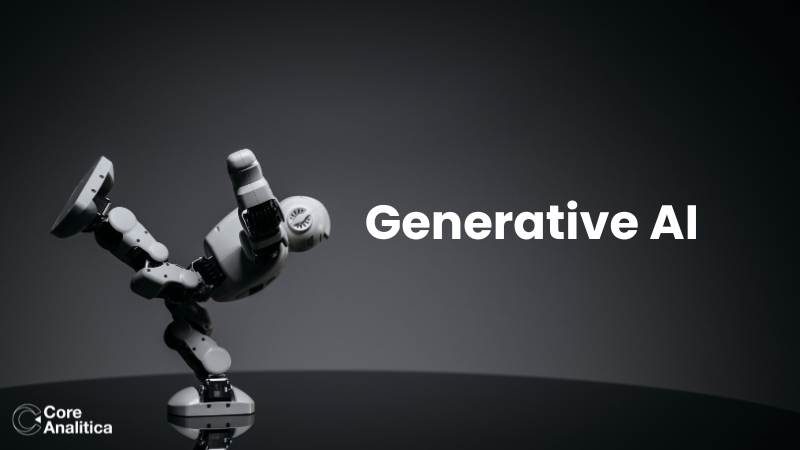
Generative AI: Transforming Business with Innovative Solutions
Generative AI is an exciting branch of artificial intelligence (AI) that goes beyond simply analyzing data. It creates new content, from images and text to music and virtual environments. This technology is rapidly changing how businesses operate by enhancing various processes, from making predictions to creating personalized user experiences. Let’s explore how generative AI can benefit your business in six key areas.
Prediction and Forecasting
One of the key strengths of generative AI lies in its predictive capabilities. By analyzing historical data and identifying underlying patterns, generative models can forecast future trends and outcomes with remarkable accuracy. This application is invaluable in industries such as finance, weather forecasting, and supply chain management, where the ability to anticipate market fluctuations, weather patterns, or demand spikes can lead to significant competitive advantages.
Example: In finance, generative AI models can analyze historical stock market data to predict future price movements, helping traders make informed investment decisions and mitigate risks.
Decision Making
Generative AI also plays a crucial role in decision-making processes by simulating various scenarios and recommending optimal courses of action. By leveraging vast amounts of data and advanced algorithms, these systems can identify potential outcomes, weigh the associated risks and rewards, and provide actionable insights to guide decision-makers. This application is particularly useful in complex domains such as healthcare, business strategy, and resource allocation.
Example: In healthcare, generative AI models can analyze patient data, medical records, and clinical guidelines to recommend personalized treatment plans for individual patients, optimizing outcomes and minimizing adverse effects.
Segmentation and Classification
Generative AI excels at segmenting and classifying data, allowing organizations to organize and categorize information more effectively. Whether it’s identifying objects in images, detecting anomalies in datasets, or clustering similar documents, these models can automate tedious tasks and extract valuable insights from large volumes of data. This application is essential in fields such as e-commerce, cybersecurity, and image recognition.
Example: In e-commerce, generative AI algorithms can analyze customer purchase histories and browsing behavior to segment users into distinct demographic groups, enabling targeted marketing campaigns and personalized product recommendations.
Recommendation Systems
Generative AI powers recommendation systems that deliver personalized suggestions and content to users based on their preferences and behavior. By analyzing past interactions and learning from user feedback, these systems can anticipate user needs and provide tailored recommendations that enhance user experience and drive engagement. This application is ubiquitous in platforms ranging from streaming services and e-commerce websites to social media and online learning platforms.
Example: Streaming platforms like Netflix leverage generative AI to analyze user viewing habits and preferences, recommending movies and TV shows that align with individual tastes and interests.
Content Creation
Perhaps one of the most captivating aspects of generative AI is its ability to create new and original content across various mediums, including text, images, music, and videos. By learning from existing examples and understanding underlying patterns, these models can generate content that is indistinguishable from human-created works, fueling creativity and innovation in fields such as art, design, and entertainment.
Example: Generative AI models like OpenAI’s GPT-3 can generate coherent and contextually relevant text across a wide range of topics, from news articles and creative writing to technical documentation and conversational dialogue.
Conversational User Interfaces
Generative AI powers conversational user interfaces (CUIs) that interact with users in natural language, enabling seamless communication and interaction with digital systems. Whether it’s chatbots, virtual assistants, or voice-enabled interfaces, these systems can understand user queries, generate appropriate responses, and adapt to context, creating more intuitive and engaging user experiences.
Example: Virtual assistants like Apple’s Siri and Amazon’s Alexa utilize generative AI to understand user commands, answer questions, and perform tasks such as setting reminders, sending messages, and controlling smart home devices.
Conclusion
Generative AI represents a transformative force in the field of artificial intelligence, unlocking new possibilities and redefining the boundaries of creativity and innovation. From prediction and decision-making to content creation and conversational interfaces, the applications of generative AI are vast and diverse, offering profound benefits across numerous industries and domains. As research and development in this field continue to advance, the potential for generative AI to shape the future of technology and society is truly limitless.
Recent Posts
- Beyond the Rear-View Mirror: How Modern Analytics Is About Predicting the Future, Not Just Reporting the Past
- “What If…?” — Moving from Static Dashboards to Strategic Conversations with Your Data
- The Power BI Revolution: Why Giving Data to Everyone Is the Smartest Business Move
- Why Your Data “Plumbers” Are Your Most Valuable Growth Asset
- Data-Driven or Data-Overwhelmed? How to Build a Culture That Actually Uses Analytics

